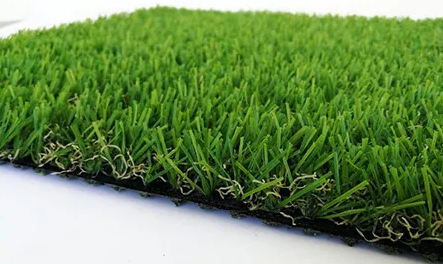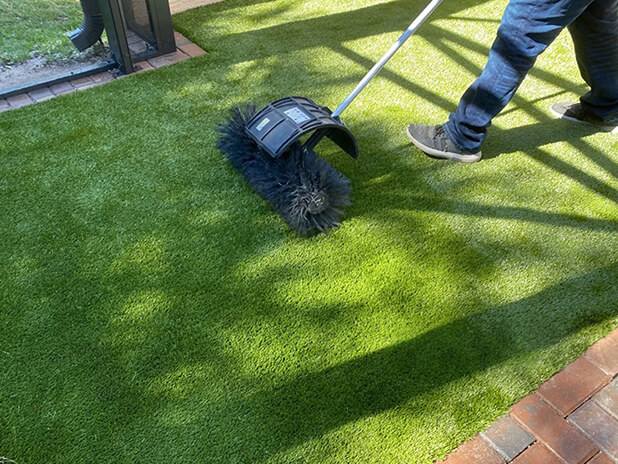
Introduction
Artificial turf has become a popular choice for homeowners seeking a low-maintenance, year-round green lawn. However, despite its minimal upkeep, it still requires some care to maintain its beauty and durability. In this article, we will explore the key steps to ensure your artificial turf stays in top condition for years to come.
1. Understanding Artificial Turf
What is Artificial Turf?
Artificial turf, also known as synthetic grass, is an engineered surface designed to replicate the appearance of natural grass. Made from durable materials such as polyethylene, polypropylene, or nylon, it offers a robust and long-lasting solution to traditional grass. Artificial turf is tufted into a backing material and can mimic the color and texture of natural grass, making it an attractive choice for both residential and commercial landscapes. Unlike natural grass, artificial turf requires no watering, mowing, or fertilizing, making it a low-maintenance alternative. However, to ensure it stays functional and appealing, regular care is still necessary.
Why Choose Artificial Turf?
Choosing artificial turf offers several key benefits for homeowners and businesses. Firstly, it helps conserve water, making it an environmentally friendly option. Traditional grass lawns often require frequent watering, which can add to water consumption and maintenance costs. With artificial turf, you can achieve a lush, green appearance year-round without the need for constant watering or fertilizer. Additionally, artificial turf is incredibly durable and can withstand heavy foot traffic, making it perfect for sports fields, playgrounds, and areas with high activity. It’s also designed to endure various weather conditions, ensuring that it looks great regardless of whether it’s sunny, rainy, or snowy. This durability, combined with its aesthetic appeal, makes artificial turf an attractive, long-term investment.
Common Misconceptions About Artificial Turf Maintenance
A common misconception about artificial turf is that it requires no maintenance. While it does not require the same level of care as natural grass, it still benefits from regular attention. Over time, dirt, debris, and even stains can build up, affecting the turf’s appearance and function. Unlike real grass, which can recover from damage over time, artificial turf needs to be cleaned and maintained regularly to keep it looking fresh and to prevent long-term damage. This includes tasks such as brushing, rinsing, and removing debris to maintain the turf’s integrity.
![Maintenance And Cleaning Artificial Grass Maintenance And Cleaning Artificial Grass]()
2. Routine Maintenance Steps
2.1 Clean and Remove Debris
Regularly clearing debris like leaves, twigs, and dirt is one of the simplest and most effective ways to maintain your artificial turf. If left unchecked, these materials can cause problems such as odors, bacterial growth, and even damage to the turf fibers. Removing debris also ensures that the grass remains clean and safe for pets and children to play on.
Tools Needed:
Leaf blower: A leaf blower is an efficient way to quickly clear leaves and other debris from the surface.
Synthetic bristle rake: A synthetic bristle rake is gentler on artificial turf fibers, ensuring that the blades of grass aren’t damaged during cleaning.
Tip: Regular cleaning is especially important after strong winds or storms when debris can quickly accumulate, potentially damaging the turf if left too long.
2.2 Regular Brushing
Regular brushing is essential for keeping your artificial turf looking natural and well-maintained. High foot traffic can cause the fibers to flatten, resulting in a less-than-ideal appearance. Brushing against the grain of the fibers helps them stand upright, maintaining a more realistic, lush look.
How to Brush:
Use a synthetic or plastic rake to brush the fibers gently.
Focus on the areas with the highest foot traffic, as these are more prone to matting and flattening.
2.3 Rinsing the Turf
Rinsing artificial turf with water is another important step in maintenance. It helps remove dust, dirt, pollen, and other debris that can accumulate over time. Regular rinsing ensures that the turf maintains its fresh, clean look and that contaminants don’t cause wear and tear on the fibers.
Why Rinse?
Rinsing removes surface dust and dirt.
It helps maintain the turf's appearance and keeps it looking vibrant.
Rinsing can prevent the build-up of contaminants like pollen, pet waste, or dust.
3. Stain Removal for Artificial Turf
3.1 Mild Stains (e.g., Drinks, Food Spills)
While artificial turf is resistant to most stains, it’s still important to act quickly when spills happen. Common substances like cola, coffee, or pet urine can leave stains if not cleaned promptly.
How to Clean:
Blot the stain with a clean towel or absorbent material.
Rinse the area with a solution of mild detergent and water.
For stubborn stains, use a diluted ammonia solution (3% ammonia and water).
3.2 Stubborn Stains (e.g., Oil, Grease)
Tough stains, such as motor oil or cooking grease, may require stronger cleaning agents. Mineral spirits can help break down these stains, making them easier to clean.
How to Clean:
Apply mineral spirits to the stained area.
Gently blot the excess liquid away.
Thoroughly rinse with cool water to remove any remaining residue.
3.3 Sticky Substances (e.g., Tree Sap, Chewing Gum)
Sticky substances like tree sap or chewing gum can be tough to remove but can be easily handled with dry ice or aerosol refrigerants. Freezing the substance makes it easier to scrape off.
How to Clean:
4. Pet Waste Management
4.1 Cleaning Pet Waste
Artificial turf is a pet-friendly option, and cleaning up after your furry friends is simple. You can easily pick up solid waste and rinse away any urine spots to maintain a fresh, odor-free lawn.
How to Clean:
Allow solid waste to dry before picking it up.
Rinse urine spots with cool water to prevent odors from accumulating.
Use a hose or specialized turf cleaner for deeper cleaning if necessary.
4.2 Preventing Damage from Pet Activities
Pets, especially active ones, can be hard on artificial turf. However, with a little care, you can prevent long-term damage. Regularly rinse the turf and use pet-friendly infill to maintain its structure and odor-free condition.
Tip: Using pet-friendly infill materials can help reduce odors and ensure the turf remains hygienic and safe for pets.
5. Seasonal Care and Long-term Maintenance
5.1Preparing for Changing Weather
Artificial turf is designed to endure various weather conditions, but it’s important to adjust your maintenance routine for seasonal changes. In cold climates, snow can build up on the turf, and in hot weather, the turf can fade.
How to Prepare:
Clear snow off the turf with a broom or plastic shovel to avoid damage from heavy snow accumulation.
In hot weather, cover the turf during the hottest part of the day to prevent fading and heat damage.
5.2 Annual Deep Cleaning
Once a year, it’s important to perform a more thorough cleaning to maintain the quality and appearance of your artificial turf. This includes brushing the fibers, rinsing the surface, and checking for any areas that need repair.
How to Clean:
Deep brush all areas of the turf to ensure fibers stand upright.
Rinse thoroughly to remove dirt and contaminants.
Check for any wear and tear, and add infill as needed to maintain the turf’s structure.
6. Equipment You’ll Need for Artificial Turf Maintenance
6.1 Essential Tools
To maintain artificial turf, you’ll need some basic tools:
| Tool | Purpose | Recommendation |
| Leaf blower | Clears leaves and light debris | Ideal for large areas or frequent debris |
| Synthetic rake | Lifts fibers and removes debris without causing damage | Use for high-traffic areas |
| Hose | Rinses the turf and removes contaminants | Regularly rinse for dust and debris removal |
Tip: Use synthetic or plastic bristles when using a rake to avoid damaging the turf.
6.2 Optional Tools for Enhanced Maintenance
To further enhance your maintenance routine, consider adding the following tools:
Lawn vacuum: Helps remove smaller debris and dirt.
Turf deodorizer: Keeps the turf smelling fresh, especially after pets.
Conclusion
Artificial turf is a low-maintenance option that offers beauty and durability. While it doesn’t require the same upkeep as natural grass, regular care is essential to maintain its aesthetic appeal and functionality. Simple steps like cleaning debris, brushing the fibers, and removing stains will help keep your turf looking pristine for years. With minimal effort and the right tools, your artificial turf can continue to enhance your yard or commercial property, providing a beautiful, long-lasting surface for everyone to enjoy.
XiHY provides high-quality artificial turf products that offer long-lasting value, making them an excellent choice for both residential and commercial properties.
FAQ
Q: How do I maintain artificial turf?
A: Regular maintenance includes brushing the fibers, cleaning debris, and rinsing the turf to remove dust and contaminants. These simple steps ensure the longevity of your artificial turf.
Q: Can I use a pressure washer on artificial turf?
A: It's not recommended to use a pressure washer as it can damage the turf fibers. Instead, use a hose with cool water to rinse the surface gently.
Q: Does artificial turf require a lot of maintenance?
A: No, artificial turf requires minimal maintenance, such as removing debris, occasional rinsing, and brushing to keep it looking pristine.
Q: How often should I clean my artificial turf?
A: It’s best to clean your artificial turf regularly, especially after heavy rainfall or high foot traffic. Rinsing and brushing once a month should suffice.
Q: Can pets damage artificial turf?
A: While artificial turf is pet-friendly, it's important to clean up waste promptly and rinse the area to avoid odors. Pet-friendly infills can also help reduce odor buildup.













